A 'planet parade' is coming, but you may have the date wrong
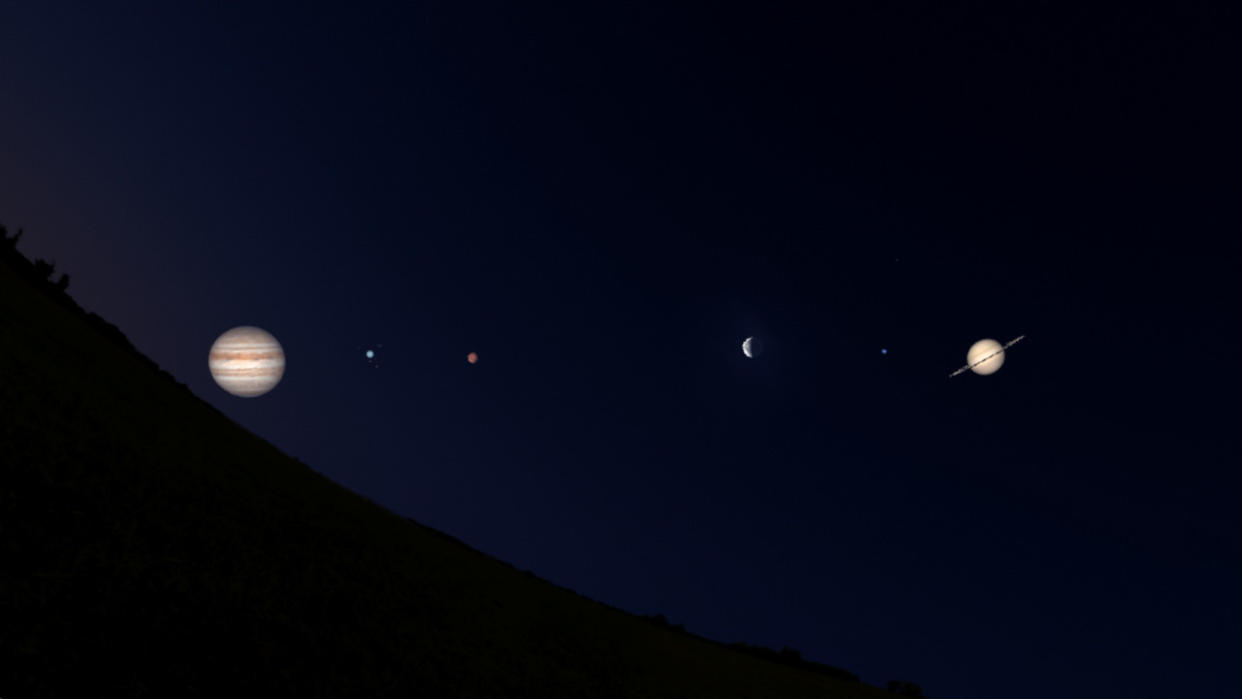
- Oops!Something went wrong.Please try again later.
There's been a lot of talk on the internet about the so-called "rare planetary alignment" that's supposedly coming up in early June. However, don't believe the hype.
The night sky can put on some spectacular events at times. There are around a dozen meteor showers that send streaks of light over our heads throughout the year. The occasional comet will wow us with its bright tails. A lunar eclipse will turn the Full Moon blood red or a solar eclipse will blot out the Sun. And yes, the planets can sometimes array themselves across the night like a string of bright pearls.
Unfortunately, the odds of being disappointed by these events can sometimes be quite high.
A meteor shower or a comet can be spoiled by the urban light pollution many of us live with on a nightly basis, or even by the light of a Full Moon. An overcast sky can ruin our chances of seeing any of these events, by completely blocking the view.
Or, sometimes, the very technological tools we use to help us get the most out of these night sky events accidentally work against us, by presenting them in a way that raises expectations to unreasonable levels.
Sadly, this appears to be the case with the "June 3rd planetary alignment" that's supposedly coming up.
According to sources on the web, this all started back towards the end of April, with an article written for the planetarium app known as Sky Tonight.
It described an alignment of six planets stretching across the sky on the morning of June 3, 2024.
"In the early morning, six planets — Mercury, Mars, Jupiter, Saturn, Uranus, and Neptune — will align in the sky," the article reads. "Mercury, Mars, Jupiter, and Saturn may be spotted with the naked eye, but you'll need a telescope or high-powered binoculars to see Neptune and Uranus. Let's take a closer look at the conditions for observing the planets."
Indeed, if we use a free planetarium program like Stellarium to view this event, it does look fairly impressive. In addition to those six planets, even the Waning Crescent Moon gets in on the show!

A simulated view of the sky at 5:15 a.m. EDT, on June 3, 2024, from southwestern Ontario, shows six planets lined up along with a thin Waning Crescent Moon. To make the alignment stand out better, the planets are presented as 150 times their normal size, the Moon is shown at 4 times its normal size, and the background stars have been dimmed. (Stellarium/Scott Sutherland)
However, in addition to all of the adjustments made to the above view to make the planetary alignment stand out, there's also one crucial feature missing from it.
To better represent what the sky will really look like at that time, the simulation needs to also account for the effects of Earth's atmosphere.
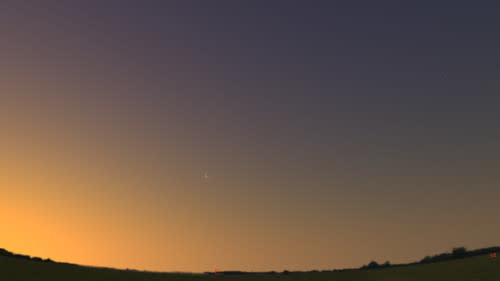
This view of the sky shows the exact same scene as the previous image, from the same location and at the exact same date and time, however the celestial objects have been returned to their normal size and the effects of Earth's atmosphere have been added back into the simulation. (Stellarium)
The problem with all of the hype about this 'planet parade' is that the timing of the event will make it impossible for us to actually see all of it.
While Saturn, Neptune, and Mars rise before morning twilight, from our perspective here on Earth, Mercury, Jupiter, and Uranus are very close to the Sun right now. Thus, by the time all six planets have crested the horizon, the entire sky will be lit up by the rising Sun.
So, despite all the hype about seeing a 'six-planet parade' in the sky, sadly, it won't be visible to us — at least not on 3rd of June. More on that, below.
What will we see on June 3?
The Sun may be spoiling our view of the full planet parade on June 3, but for those of us with clear skies, we may be able to see part of it.
If you are up very early on that day, before morning twilight begins, Mars, the Moon, and Saturn will be together in the eastern sky. Neptune will also be there, but will not be visible to the unaided eye. A telescope or pair of binoculars will be needed to see it.
Saturn rises around 2:20 a.m., the Moon follows at around 3:10 a.m., and Mars crests the horizon around 3:30 a.m., local time.
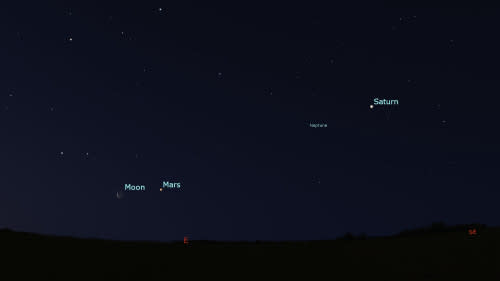
The part of the June 3 planet alignment that will actually be visible in the predawn sky is shown in this simulation, with reveals the predawn eastern sky at 4:20 a.m. local time. (Stellarium/Scott Sutherland)
If June 3 doesn't work for you, these same objects will be together in the eastern predawn sky from around May 28 through June 5, with the Moon starting off to the west of Saturn and tracking past the planets throughout that week.
DON'T MISS: Take a mind-bending plunge into a supermassive black hole
The real 'planet parade' is still to come
If you really want to see multiple planets lining up in a 'parade', keep your eyes on the eastern pre-dawn sky as the month of June progresses. However, be sure to watch before twilight begins, as that will make it easier to see.
On the 1st and 2nd of the month, the Waning Crescent Moon will be situated between Mars and Saturn, just above the eastern horizon. Then, on the 3rd and 4th, it will have shifted over to the other side of Mars. For those with binoculars or a telescope, Neptune will be found between Mars and Saturn on all four of these nights, while Uranus will be just in the process of rising (but may be masked by the beginning of twilight).
These four planets will rise earlier and earlier throughout June, thus putting them higher in the sky when dawn approaches.
Mark June 15 on your calendar, because that will probably be the best morning to catch five planets in alignment, as Jupiter joins the others early enough to not get lost in the light of dawn.
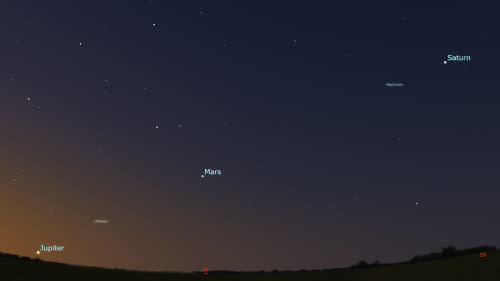
Jupiter, Uranus, Mars, Neptune, and Saturn are shown here in alignment at around 4:40 a.m. EDT on June 15, 2024, from southwestern Ontario. (Stellarium/Scott Sutherland)
Those five planets will remain visible in the night sky for the rest of the summer, rising earlier and earlier throughout the season. (Remember that Uranus and Neptune will not be visible to the unaided eye.)
Starting on the morning of June 27, all five will be well above the horizon before morning twilight starts, just in time for the Moon to join the show once again. The Waning Gibbous Moon will be hanging out near Saturn on the 27th, the Last Quarter Moon will nearly block Neptune from view on the 28th (and will completely occult the planet when viewed from farther south), and then the Waning Crescent Moon will drop into alignment with the others on the 29th.
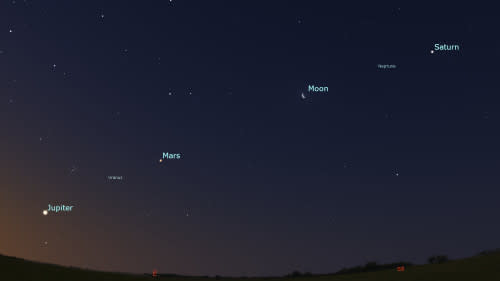
Five planets align with the Waning Crescent Moon at 4:40 a.m. on June 29, 2024. (Stellarium/Scott Sutherland)
If you keep watch on these worlds throughout the summer, you can see them change up their order in the sky as their orbits cause them to pass each other from our point of view here on Earth.
Watch for Mars and Uranus to switch places in the order around mid-July, with Mars and Jupiter slipping by each other to change things up again in mid-August.
Planetarium apps
It was mentioned, above, that the technological tools we use to help us visualize night sky events can sometimes work against us.
As the images used in this article demonstrate, these apps can present views of the sky that don't match up with reality. Some don't even have an option for factoring in whether it's day or night at your location. They simply show the position of the Sun, planets, constellations, stars, and galaxies, as they appear around Earth, at that time.
This is not to say that astronomy and planetarium apps are a bad thing, though. On the contrary, they are invaluable tools for skywatchers and stargazers of all levels of expertise and enthusiasm.
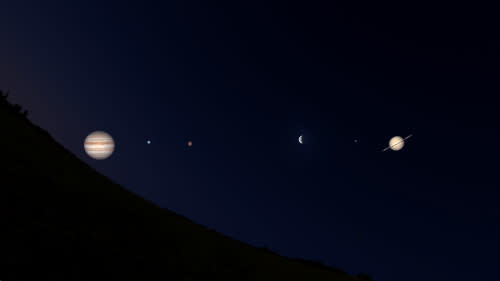
This idealized view presents the sky without the effects of Earth's atmosphere, with the planets at 1000 times their normal size in our sky, the Moon at 4 times its normal size, and with all of the stars removed. This not only emphasizes the alignment, but also demonstrates how, although these programs are quite valuable for the information they can relay, they can also present views of our sky that greatly differ from reality. (Stellarium/Scott Sutherland)
However, when we use these apps, it's up to us to be mindful of what they are showing us.
Does the app allow you to enter your location, so it can take into consideration whether it's day or night when a celestial event is occurring? Is the app presenting the Moon and planets as they would actually appear, or does it show them as oversized, idealized versions to make them stand out against the background?
Knowing the answers to these questions, or picking an app that simulates the sky as close to reality as possible, can help prevent disappointment.

